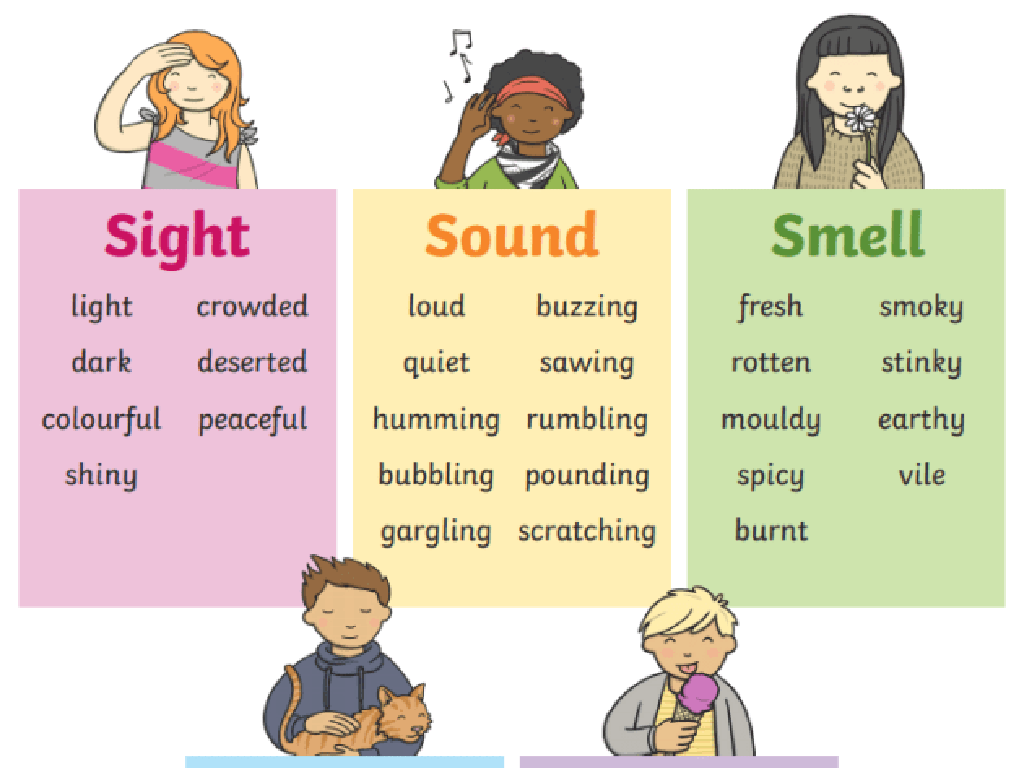Interpret Charts And Graphs To Find Mean, Median, Mode, And Range
Subject: Math
Grade: Sixth grade
Topic: Statistics
Please LOG IN to download the presentation. Access is available to registered users only.
View More Content
Welcome to Statistics: Understanding Data
– What are Mean, Median, Mode, and Range?
– Mean is the average, Median is the middle value, Mode is the most frequent, Range is the difference between highest and lowest.
– Real-life importance of these concepts
– These help us summarize and understand large amounts of data quickly, such as in sports or weather reports.
– Overview of today’s statistics lesson
– Engaging activities planned
– We’ll use examples and class activities to explore these concepts.
|
This slide introduces the fundamental concepts of statistics that are crucial for understanding and interpreting data. Mean, median, mode, and range are the building blocks for data analysis, which students will encounter in various real-life situations, such as calculating averages in sports, understanding trends in weather, or comparing test scores. Emphasize the practicality of these concepts and how they can make sense of numbers in a meaningful way. Today’s lesson will include a mix of explanation, examples, and hands-on activities to reinforce these concepts. Prepare to guide students through exercises that involve analyzing data sets to find these statistical measures.
Understanding Mean in Statistics
– Mean: The average value
– Mean is found by adding all numbers in a set and dividing by the count of numbers.
– Calculate mean: Add and divide
– To find the mean, sum all the numbers (3+5+7+9+11) and divide by how many numbers there are (5).
– Example: Mean of 3, 5, 7, 9, 11
– Adding 3, 5, 7, 9, 11 gives 35. Dividing 35 by 5 (the number of values) gives us 7, which is the mean.
|
The slide introduces the concept of mean, which is a fundamental statistical measure used to find the average value in a set of numbers. It’s important to explain the process step by step: first, add all the numbers together to get a total sum, then divide this sum by the number of values in the set. Use the example provided to walk through the calculation process. The mean of the numbers 3, 5, 7, 9, 11 is calculated by adding them to get 35, then dividing by 5, since there are 5 numbers, resulting in a mean of 7. Encourage students to practice with different sets of numbers to become comfortable with the concept.
Understanding Median in Statistics
– Median: Middle value in a list
– When numbers are in order, median is the center number
– How to find Median: Order the numbers
– Arrange from smallest to largest, then locate the middle
– Example: Median of 3, 5, 7, 9, 11
– In 3, 5, 7, 9, 11, the median is 7, as it’s the middle of the list
|
The median is a type of average that represents the middle value of an ordered list of numbers. To find the median, students should first arrange the numbers in ascending order. If there is an odd number of values, the median is the one in the middle. If there is an even number of values, the median is the average of the two middle numbers. In the example provided, the list is already in order, and since there are five numbers, the third number, 7, is the median. This concept is fundamental in understanding data distribution and is a stepping stone to more complex statistical analysis. Encourage students to practice with different sets of numbers, both odd and even in count, to solidify their understanding.
Understanding Mode in Statistics
– Define mode in a dataset
– Mode is the most repeated number in a set
– Recognize multiple or no modes
– A set may have 1+ modes or none
– Example: Mode of given numbers
– For 3, 5, 7, 5, 11, mode is 5
– Mode’s role in data analysis
|
The mode is a basic statistical measure that represents the most frequently occurring number in a dataset. It’s important for students to understand that while a dataset may have one mode, it can also have multiple modes if there are several numbers that appear with the same highest frequency, or no mode if all numbers are unique. Use the example provided to illustrate how to find the mode. In this case, the number 5 appears twice while all others appear once, making 5 the mode. Discuss with students how mode can provide insights into the most common or popular items in a dataset, such as the most common shoe size sold in a store.
Understanding Range in Statistics
– Range: Difference between high and low
– It measures the spread of a data set.
– How to calculate range
– Subtract smallest value from largest value.
– Example: Range of 3, 5, 7, 9, 11
– Subtract 3 (smallest) from 11 (largest) to find range.
|
The concept of range is a fundamental statistical tool that measures the spread or dispersion within a set of numbers. To calculate the range, students should identify the highest and lowest numbers in a data set and then subtract the smallest number from the largest. For example, with the numbers 3, 5, 7, 9, 11, the range is 11 – 3, which equals 8. This indicates that the spread of the numbers is 8 units. Encourage students to practice with different sets of numbers to become comfortable with finding the range. This exercise helps students understand how varied the data is and is a stepping stone to more complex statistical concepts.
Interpreting Data with Charts and Graphs
– Visual representation of data
– Data is shown using images like bars or lines
– Types of charts and graphs
– Bar graphs, line graphs, pie charts show data differently
– Interpreting graph data
– Look for patterns, trends, and compare values
– Mean, median, mode, range
– Use data to calculate average, middle, most, and spread
|
This slide introduces students to the concept of using charts and graphs to interpret data. Emphasize that these visual tools help us to quickly understand and analyze information. Explain the different types of graphs and what kind of data they are best suited for. Teach students how to read the axes, identify key points, and understand what the graph is showing. Then, connect this to finding the mean, median, mode, and range by using the data from the graphs. Provide examples of each type of graph and demonstrate how to extract these statistical measures. Encourage students to practice with real data sets to solidify their understanding.
Applying Statistics: Mean, Median, Mode, and Range
– Let’s calculate: mean, median, mode, range
– Mean is the average, median is the middle value, mode is most frequent, range is the difference between highest and lowest
– Identify the data set in the graph
– Look for numbers or categories that represent the data we will analyze
– Class calculation walkthrough
– We’ll solve step-by-step as a group, ensuring everyone follows
– Understanding through practice
|
This slide is an interactive class activity designed to apply the concepts of mean, median, mode, and range to a real graph. Begin by explaining the terms with definitions and simple examples. Then, present a graph to the class and guide them to identify the relevant data set. Work through each calculation methodically, asking students to participate in each step. This reinforces their understanding and allows them to see the practical application of these statistical measures. Encourage questions and assist students who need additional help. Possible activities include breaking the class into groups to calculate different measures, having volunteers come up to the board to demonstrate their calculation, or using real-life data sets that would interest sixth graders.
Group Challenge: Mastering Data Analysis!
– Split into groups for chart analysis
– Calculate mean, median, mode, range
– Mean: Add all numbers, divide by count
– Collaborate and interpret your findings
– Median: Middle value in ordered list
– Prepare a class presentation
– Mode: Most frequently occurring number
|
This class activity is designed to encourage collaborative learning and application of statistical concepts. Divide the class into small groups and assign each a different chart or graph. Each group will calculate the mean by adding all the numbers and dividing by the total count, find the median by identifying the middle value in an ordered list, determine the mode by finding the most frequently occurring number, and calculate the range by subtracting the smallest value from the largest. After calculations, students should discuss what their findings might indicate about the data set. Finally, each group will prepare a short presentation to share their analysis with the class. This activity will help students understand how to interpret real data and enhance their presentation skills.
Conclusion: Understanding Data with MMMR
– Recap: Mean, Median, Mode, Range
– Mean: average, Median: middle value, Mode: most frequent, Range: difference between highest and lowest
– Significance of MMMR in data
– These measures summarize data to make it understandable and actionable
– Interactive Q&A session
– Review key concepts
– Reinforce learning with examples and answer any lingering questions
|
This slide wraps up the lesson on statistics by reviewing the concepts of mean, median, mode, and range. Emphasize how these measures of central tendency and variability provide a snapshot of data, making it easier to analyze and interpret. During the Q&A session, encourage students to ask questions about any aspect of MMMR they find confusing. Use this opportunity to clarify misunderstandings and solidify their grasp of the material. Engage the class with examples they’ve worked on and ensure they can apply these concepts to different sets of data. This review is crucial for their upcoming assessments and practical application of statistics.






